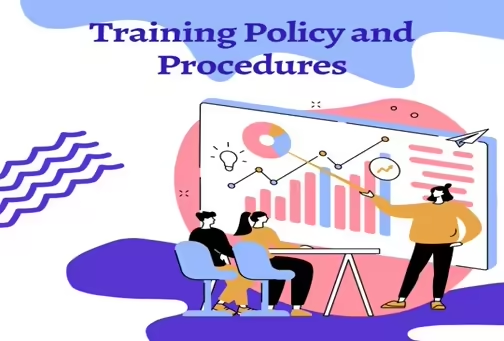The training policy and procedures are the blueprints for your organization's approach to training and development and the goals you want to achieve. Managers of training programs, human resources experts, and those in charge of delivering training all benefit from their clarity and guidance. Reviewing and revising your policies and procedures regularly can help you keep your training program up-to-date and relevant.
Every organization wishes to continuously improve staff skills, knowledge, and competencies to support current and future business goals and plans. Organizations usually thrive on an ongoing learning culture in which employees at all levels are encouraged to participate in some training.
This guide outlines what your organization may incorporate into your training policy and procedures. This article will discuss the most common training policies and procedures and the many training options available to meet your organization's specific needs. In addition, if you are a student who reads this article you also can purchase college essays to spend more time on reviewing and exploring training policy and procedures for employers.
Find out more: Creating a Diversity and Inclusion Training Program
Significance of a training policy and procedures
An Employee Training Policy provides a framework for employees to expand their knowledge and learn new skills in a competitive environment. It should also aim to develop employees to perform better in their current roles and then progress to their next positions. According to 360 learning, 70% of employees believe they lack the necessary skills for the job, and according to Gartner Talent Neuron, since 2017, the total number of skills required for a single job has increased by 10% year on year. This demonstrates how important it is for organizations to create a training policy and procedures.
Employees, supervisors, and Human Resources (HR) should all work together to create a culture of continuous professional development. It is the job of managers to coach their teams and identify employee development needs. The employee must seek out fresh learning opportunities.
According to the World Economic Forum, training and development is significant for the future of work and mitigate job losses and talent shortages. All relevant stakeholders must work together proactively and strategically to manage upskilling.
Various types of training
An organization is only as good as its employees, and to perform at their best, employees must be adequately trained. Employee training programs that are effective have numerous advantages, ranging from a reduction in turnover to increased productivity.
Below are some of the most popular types of training that you may consider as you create your training policy and procedures.
Orientation and Onboarding Training
Orientation generally falls under the larger umbrella of onboarding, a longer-term form of employee training. The onboarding process provides new hires with the tools they need to get started in their role. Department heads or direct managers generally create onboarding programs tailored to their units or individual hires. An effective orientation provides new hires with the basic organizational information they need to prepare for their role in a company.
Product Training
This type of training encompasses all the information about your organization's services or products that employees need to know to do their jobs well. Companies cannot effectively sell their products unless their employees understand them. Once understanding is established it will be possible for them to promote or market them.
The goal of product training is to ensure that employees understand what their company offers, both internally and externally. The emphasis is not on selling the product. This type of employee training is not a direct replacement for sales training.
Team Training
Team training programs increase employee engagement and productivity. They foster positive relationships among team members, promote equal access to professional development opportunities, and boost employee morale, collective efficacy, and member satisfaction.
Team training can be delivered in an intensive format, such as during a retreat or over weeks or months. Interpersonal communication, process improvement and management, and goal-setting are common focus areas for team training programs.
Technical Training
Technology is advancing rapidly, and job descriptions are evolving quickly due to market demand. According to Gartner, 58% of employees must learn new skills to do their jobs effectively. For organizations, this means they will be unable to maximize their employees' performance unless they take steps to address the resulting skill gaps.
This can be achieved through Technical skills training. It is one of the more basic types of employee training. Usually, it consists of courses that teach specific skills, such as data analytics or social media management.
Leadership Training
The transition from individual contributor to manager is a critical turning point in an employee's career. However, far too often, businesses offer little assistance during this transition. Leadership training becomes an important step that should be taken as it ensures that the employee will be guided into their new role.
Leadership training is a type of soft skill training that focuses on interpersonal abilities while emphasizing leadership qualities and skills that directly impact leading others. This type of training assists in developing key Leadership skills such as employee motivation, delegation, and giving feedback.
Related: On-the-Job Training
What to include in your training policy and procedures?
Every year, Human Resources has to create and update a training plan that considers the organization's ongoing efforts and long-term goals. The document lays out the year's worth of training goals and objectives. The training policy's goals and objectives should be made crystal clear. This way, your strategy will be carried out effectively, and your staff will gain the most from it in their professional growth.
In your training policy and procedures, the following must be included:
- What does the organization value in employee development?
- The organizational structure for providing training and development activities.
- The emphasis on ongoing professional development.
- Competencies and behaviours necessary at work.
This information is not to be provided haphazardly but must fit into the following framework:
Purpose
Under this sub-heading, you are to provide an overview of the training and development policy and its rationale and a description of the organization's attitude toward training and development.
Scope
This will specify which employees are eligible for the coverage and under what circumstances.
Principles
You must explain the method and criteria used to establish the needs for training and development and any performance evaluation systems that will be implemented. This is the most important part of any policy, and it must specify in as much detail as possible what is required to achieve the overall training and development goals. It would help if you involved all personnel in the activity, such as the Training and Development department, line managers, and external providers.
Training and development requirements must be prioritized in relation to organizational priorities, activities, and requirements. As mentioned earlier, customized training programs should mirror the organization's challenges, difficulties, or initiatives.
Under Principles, you must also include a description of the method and standards that must be followed while designing training provisions. This should also have a list of the organization's numerous formal methods of training and development delivery, such as face-to-face, virtual, and action learning.
According to Unboxed Training and Technology, Evaluation of training effectiveness offers a clear picture of what content employees are familiar with and indicates development possibilities. As a result, making evaluations after any training is provided, as well as how assessments will be done following training, must be mentioned in your principles. This outlines how employees will be assessed as a result of their training and development. Employees' occupational competencies and credentials must be indicated as well. You must also specify who will be in charge of training and development (internal and external providers) and the criteria for selecting and evaluating them.
Procedures
A description of how training and development will be given is a vital component of any training and development policy. Here you should provide a step-by-step process of how the training and development will be done. The steps must clearly demonstrate how the assessment, motivation, design, delivery, and evaluation of the training will be done. For the purposes of clarity and smooth implementation of the training, these steps must be written in chronological order. It must also clearly state which stakeholder will carry out or will be involved in the step for all the steps in the process.
Responsibilities
It is essential for all stakeholders concerned with this policy to be able to understand clearly what their duties will be. These duties must have a direct impact on the smooth implementation of the training policy and procedures. Here it would help if you listed all the stakeholders involved and their duties.
Implementing the right training program for your company allows you to create rich learning opportunities that truly empower your employees to grow with the company. Consider the overall organizational and individual employee requirements as you create the training policy and procedures.
Conclusion
If a company wants to ensure its training programs are productive and successful, it needs a training policies and procedures manual. The training policies and procedures should be approved by upper management after they have been reviewed for consistency with the organization's long-term strategy and objectives. They specify the organization's training program's aims and objectives and the appropriate methods for designing, delivering, and assessing training interventions.
While the specifics of these policies and procedures may need to be adjusted as the company develops and grows, the underlying ideas and goals should stay consistent. It's also essential for workers to know what they're responsible for in terms of enforcing the policy and practice between themselves.
The training policies and procedures symbolize the company's dedication to its employees' growth and development, which is critical to its long-term success. Moreover, they aid in making sure that all workers know what is expected of them in terms of training, which is essential for a healthy, fair, and productive workplace. Last but not least, training policies and procedures ensure that all training is conducted consistently and compliant, both of which are critical for meeting the training and development requirements of the organization.
Natasha Chimphondah is an organizational development consultant at Industrial Psychology Consultants (Pvt) Ltd, a business management and human resources consulting firm.
LinkedIn: https://www.linkedin.com/in/natasha-chikondi-chimphondah-9b62a9159/
Phone: (0242) 481946-9/481950
Mobile: (+263) 783836901
Email: natasha@ipcconsultant.com
Main website: www.ipcconsultants.com



